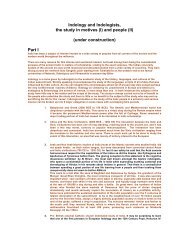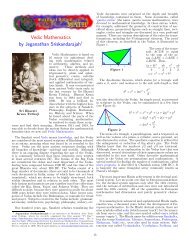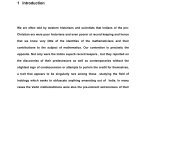The Dhaarmik Traditions - Indic Studies Foundation
The Dhaarmik Traditions - Indic Studies Foundation
The Dhaarmik Traditions - Indic Studies Foundation
You also want an ePaper? Increase the reach of your titles
YUMPU automatically turns print PDFs into web optimized ePapers that Google loves.
textual commentaries, often line by line, of the first 18 books, of the corresponding<br />
Samhita of the Yajurveda. <strong>The</strong> following 5 books cover supplementary and ritualistically<br />
newer material, besides including the celebrated Brihadaaranyaka Upanishad as most of<br />
the 14th and last book. <strong>The</strong> Shatapatha Brahmana was translated into English by Prof.<br />
Julius Eggeling, in the late 19th century, in 5 volumes published as part of the Sacred<br />
Books of the East series. Retrieved from<br />
"http://en.wikipedia.org/wiki/Shatapatha_Brahmana"<br />
124<br />
125<br />
126 Shakti,िशक्त the female energy principle, in the <strong>Indic</strong> tradition ,the primordial icon of strength and<br />
energy is associated with the feminine gender<br />
127 Shaanti peace of mind attained through the disciplines of Raja Yoga<br />
128 Shaucha<br />
129 Sidereal Day A mean sidereal day is about 23h56m in length. Due to variations in the rotation rate of<br />
the Earth, however, the rate of an ideal sidereal clock deviates from any simple multiple<br />
of a<br />
130 Sidereal Month Sidereal month <strong>The</strong> actual period of the Moon's orbit as measured in a fixed frame of<br />
reference is known as a sidereal month, because it is the time it takes the Moon to return<br />
to the same position on the celestial sphere among the fixed stars (Latin: sidus): 27.321<br />
661 days (27 d 7 h 43 min 11.5 s) or about 27 ⅓ days. This type of month has appeared<br />
among cultures in the Middle East, India, and China in the following way: they divided<br />
the sky in 27 or 28 lunar mansions, characterized by asterisms (apparent groups of<br />
stars), one for each day that the Moon follows its track among the stars.<br />
131 Sidereal Time During the course of one day, the earth has moved a short distance along its orbit<br />
around the sun, and so must rotate a small extra angular distance before the sun<br />
reaches its highest point. <strong>The</strong> stars, however, are so far away that the earth's movement<br />
along its orbit makes a generally negligible difference to their apparent direction (see,<br />
however parallax), and so they return to their highest point in slightly less than 24 hours.<br />
A mean sidereal day is about 23h56m in length. Due to variations in the rotation rate of<br />
the Earth, however, the rate of an ideal sidereal clock deviates from any simple multiple<br />
of a civil clock.<br />
132 Sidereal Year In order for the earth to attain the same position with respect to a fixed star after one<br />
revolution, it takes a time span of 365 days 6 hours 9 minutes and some 9.5 seconds.<br />
This duration of time is called a sidereal year .<strong>The</strong> sidereal year is just over 20 minutes<br />
longer than the tropical year; this time difference is equivalent to 50.26 seconds of<br />
celestial longitude.Each year, the Vernal equinox will fall short by 50.26 seconds along<br />
the zodiac reckoned along the fixed stars.










